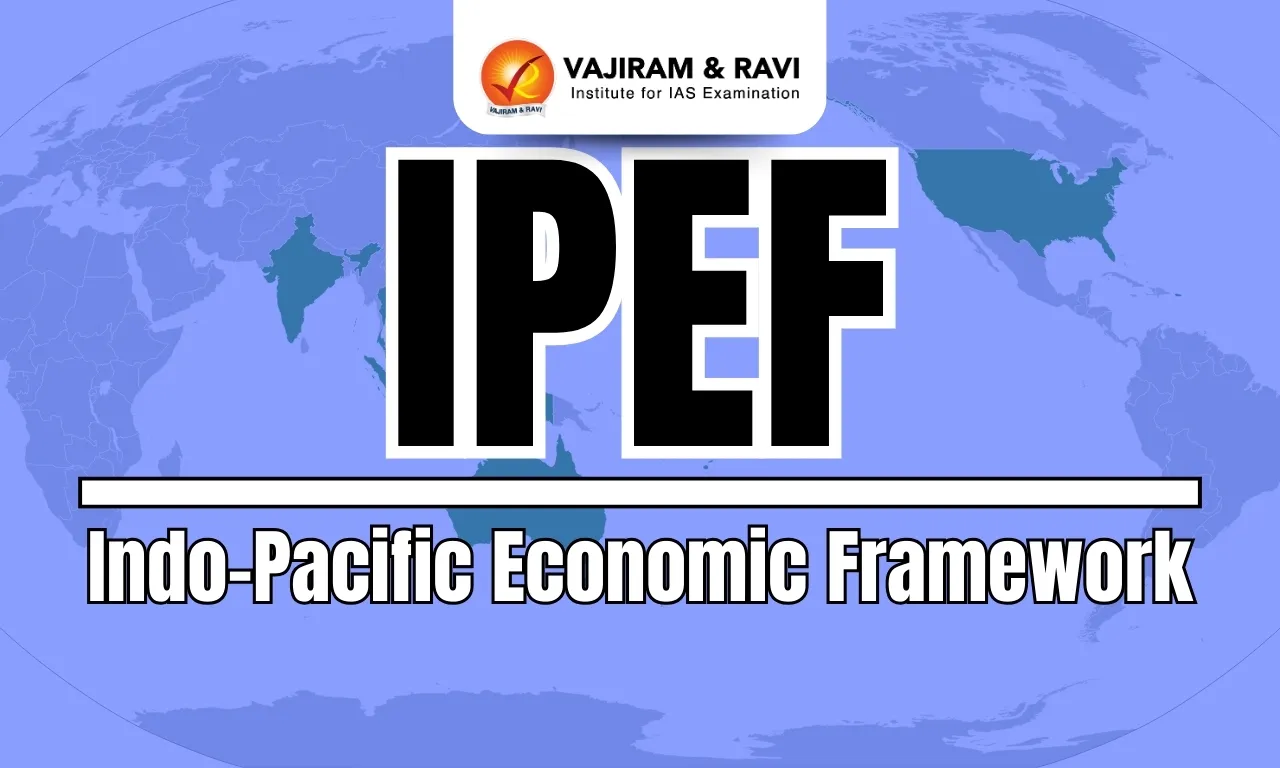What is IPEF?
The Indo-Pacific Economic Framework (IPEF) was launched jointly by the US and other partner countries of the Indo-Pacific region in 2022.- The 14 IPEF partners represent 40 percent of the global GDP and 28 percent of global goods and services trade.
- It seeks to strengthen economic partnerships among participating countries with the objective of enhancing resilience, sustainability, inclusiveness, economic growth, fairness, and competitiveness in the region.
- The 14 members of the IPEF are as follows
| Australia | Brunei | Fiji | India | Indonesia | Japan | South Korea, |
| Malaysia | New Zealand | Philippines | Singapore | Thailand | Vietnam | USA |
- The IPEF is not a Free Trade Agreement(FTA) but allows members to negotiate the parts they want to. The negotiations will be along four main pillars:
- Supply-chain resilience
- Clean energy, decarbonization & infrastructure
- Taxation & anti-corruption
- Fair & resilient trade
What is the extent of India’s participation in IPEF?
India has been actively participating in the IPEF, but not in all pillars:- India out of trade pillar: India has decided to opt out of the trade pillar of the Indo-Pacific Economic Framework (IPEF) as most issues promoted by the IPEF do not align with India's trade policies.
- India against market barriers: The IPEF's focus on strong labour and environment standards conflicts with India's stance and may act as market access barriers.
- No tariff cuts: The fact that the IPEF does not provide for tariff cuts also makes it unsatisfactory for India.
- Keeping economic interests as a priority: Joining the IPEF is important to keep the growing influence of China in the Asia Pacific region in check. However, India's economic interests cannot be put at stake.
- India pitching for data sovereignty: The US has expressed concerns about India's potential demands for data localization. However, India has argued that data localization is necessary to maintain data sovereignty.
What is the significance of IPEF for India?
The significance of IPEF can be analyzed through the following dimensions:- Beneficial for Indian exports: India’s trade in the region is growing rapidly. Nearly 50% of India’s trade is centered in the Indo-Pacific Region, and the Indian Ocean carries 90% of India’s trade and its energy sources.
- Countering China’s hegemony: The absence of China as a member of the group gives it a unique geopolitical character, as all the members of the group have common concerns regarding China's expansionist aspirations.
- Collaboration for energy projects: IPEF is expected to yield significant short-term economic advantages for India by fostering collaboration in clean energy investment and technology development.
- India’s leadership in Indo-Pacific: India's decision to join the IPEF is a robust indication of its dedication to advancing Indo-Pacific objectives and regional collaboration following its withdrawal from the RCEP.
- Supply-chain resilience: India can gain by expanding supply chains beyond China and also keeping itself resilient from situations like the Covid pandemic.
What are the challenges and limitations of IPEF?
The challenges and limitations of IPEF include:- Lack of clarity: The IPEF's status as a non-free trade agreement and the ambiguity around the four pillars can lead to confusion and uncertainty about its purpose and utility.
- Divergent economic arrangements: The countries involved in the IPEF have very different economic arrangements, making it difficult to find common ground and set standards together.
- Departures from traditional positions: Progress in some areas may require countries to depart from their traditional positions, which can be politically challenging.
- Taxation: Tax provisions are a sensitive issue and may be difficult to negotiate.
- Limited business representation: The views of potentially competitive Indian businesses may not be heard, and there may be a tendency towards protectionism.
- Complex negotiation process: Trade negotiations involve multiple ministries and can be cumbersome and complex.
- Credibility: Earlier similar initiatives, such as the Blue Dot Network and the Build Back Better World (B3W) Initiative, have had limited success in addressing the region's infrastructure requirements.
How does the IPEF differ from other trade deals?
The Indo-Pacific Economic Framework (IPEF) is different from other trade deals in several ways:- Non-binding: Unlike trade deals such as free trade agreements (FTAs), the IPEF is a non-binding framework for economic cooperation and connectivity in the Indo-Pacific region.
- Inclusive: The IPEF includes countries from across the Indo-Pacific region, including India, Japan, Australia, and the United States. This makes it a more inclusive initiative than some other trade deals.
- Comprehensive: The four pillars of IPEF make it a more comprehensive initiative that addresses a broader range of issues than some other trade deals.
- Focus on Non-tariff mechanisms: The IPEF does not include discussions on tariff reductions or increasing market access, which are typically the focus of traditional trade deals.
- Flexible: The IPEF provides flexibility to participants, allowing them to choose which areas they want to participate in rather than being bound by all aspects of the agreement.
- Focus on infrastructure and investment: The IPEF focuses on promoting infrastructure development, investment, and connectivity in the region. It aims to support sustainable, transparent, and high-quality infrastructure projects.
What are the future prospects of IPEF?
The future prospects of the Indo-Pacific Economic Framework (IPEF) include- Strengthen regional economic architecture: The IPEF should focus on strengthening the regional economic architecture by promoting greater coordination and cooperation among existing regional institutions.
- Expand trade and investment: The IPEF should promote greater trade and investment in the region by reducing barriers to trade and investment, improving connectivity, and enhancing the business environment.
- Develop infrastructure: Infrastructure development is critical for economic growth and development. The IPEF should work to develop high-quality infrastructure such as transportation, energy, and telecommunications.
- Promote innovation and technology transfer: It should promote greater innovation and technology transfer among member countries to enhance their competitiveness and resilience.
- Foster sustainable development: It needs to promote sustainable development by encouraging investment in green infrastructure, promoting clean energy, and supporting sustainable business practices.
- Address emerging challenges: The focus of IPEF should be on addressing emerging challenges, such as digital trade and e-commerce, cybersecurity, and climate change.
How can India play an effective role in IPEF?
India can play an effective role in the Indo-Pacific Economic Framework (IPEF) by taking the following steps:- Strengthening existing economic ties: such as signing free trade agreements (FTAs), enhancing regional connectivity, and promoting trade and investment.
- Boosting infrastructure development: India needs to focus on developing infrastructure in the region, particularly in areas such as transport, energy, and digital connectivity.
- Enhancing maritime security cooperation: Participation of India in enhancing maritime security cooperation includes strengthening maritime domain awareness, sharing of information, and capacity building.
- Promoting people-to-people exchanges: India should encourage people-to-people exchanges in the region by promoting cultural and educational exchanges, tourism, and sports.
- Supporting sustainable development: India should work towards promoting sustainable development in the region, particularly in areas such as renewable energy, clean technology, and sustainable agriculture.
Last updated on November, 2025
→ Check out the latest UPSC Syllabus 2026 here.
→ Join Vajiram & Ravi’s Interview Guidance Programme for expert help to crack your final UPSC stage.
→ UPSC Mains Result 2025 is now out.
→ UPSC Notification 2026 is scheduled to be released on January 14, 2026.
→ UPSC Calendar 2026 is released on 15th May, 2025.
→ The UPSC Vacancy 2025 were released 1129, out of which 979 were for UPSC CSE and remaining 150 are for UPSC IFoS.
→ UPSC Prelims 2026 will be conducted on 24th May, 2026 & UPSC Mains 2026 will be conducted on 21st August 2026.
→ The UPSC Selection Process is of 3 stages-Prelims, Mains and Interview.
→ UPSC Result 2024 is released with latest UPSC Marksheet 2024. Check Now!
→ UPSC Prelims Result 2025 is out now for the CSE held on 25 May 2025.
→ UPSC Toppers List 2024 is released now. Shakti Dubey is UPSC AIR 1 2024 Topper.
→ UPSC Prelims Question Paper 2025 and Unofficial Prelims Answer Key 2025 are available now.
→ UPSC Mains Question Paper 2025 is out for Essay, GS 1, 2, 3 & GS 4.
→ UPSC Mains Indian Language Question Paper 2025 is now out.
→ UPSC Mains Optional Question Paper 2025 is now out.
→ Also check Best IAS Coaching in Delhi
Indo-Pacific Economic Framework (IPEF) FAQs
Q1. When was IPEF launched??+
Q2. Is IPEF a Free Trade Agreement (FTA)?+

















